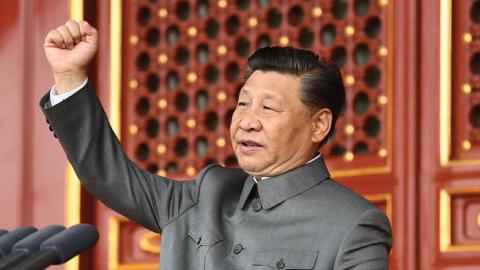Diplomatic communication is complex. It entails signaling between multiple entities, each of which has its own internal political language and structure. Offhand comments can be mistaken for government policy. April Glaspie, former Ambassador to Iraq, may have unintentionally invited Saddam’s aggression in 1990. Dean Acheson, then Secretary of State, indicated that the U.S. would not defend South Korea, possibly prompting the North’s invasion. Of course, some signals are received with the utmost clarity: John F. Kennedy’s virtual endorsement of the Berlin Wall at the Vienna Summit, and his weakness over the Cuba question, virtually blessed Khrushchev’s arms transfers to Cuba.
However, it is possible to trace the clear delivery and receipt of a diplomatic exchange that indicates a regional political shift. Xi Jinping’s July 1 speech, and Japanese Deputy Prime Minister Taro Aso’s clear statement of Japan’s support for Taiwan on July 5, is an example of such dialogue. It presents the U.S. with a clear opportunity — particularly given other allied actions in the Indo-Pacific — to solidify American and NATO links with Taiwan.
Xi’s 1 July speech, commemorating the Chinese Communist Party’s centenary, was remarkably forthright. In broad terms, Xi issued three clear policy statements. First, to foreign opponents: The CCP would use force to achieve its objectives. Second, to domestic dissenters, particularly those within the party: CCP would not tolerate policy disagreement, instead treating it as an existential threat. And finally, to the Chinese people: Prepare for the demands of the moment, as sacrifice will be necessary. Taiwanese independence, Xi indicated, would trigger a conflict.
But China’s objectives go far beyond Taiwan, and rather towards Xi’s dream of “national rejuvenation,” a concept never explicitly defined in his speech, but one that clearly indicates a world in which Chinese preferences dominate political structures. In short, Xi plans to direct the CCP and Chinese nation in a struggle for global dominance, one that will entail almost certainly a conflict over Taiwan, and most likely an Indo-Pacific military confrontation with the U.S. and its allies.
Japan’s response to China’s statements may mark the most decisive shift in Japanese foreign policy since the World War. Taro Aso, Japan’s Deputy Prime Minister, delivered a speech at a Liberal Democratic Party fundraiser in which he stated in no uncertain terms that Japan would defend Taiwan — indeed, that an attack on Taiwan would be a “survival-threatening situation” for Japan. This description is critical in Japan’s political environment because the Japanese constitution prohibits the country from waging war, a measure designed to prevent the militarism that had supercharged Imperial Japanese aggression from reasserting itself in post-1945 politics.
But the Japan Self-Defense Force, naturally, is permitted to use force to defend Japanese survival.
Japan has deployed military forces in support of U.S. operations in the past, most notably during the 1980s, when Japan Maritime Self-Defense Force ships assumed anti-submarine duties in the southern approaches to the Japanese home islands. Nevertheless, publicly signaling a commitment to Taiwan’s defense may indicate that Japan now leans toward acting more resolutely than in the past.
Japan is a member of the burgeoning “Quad” — the Indian-American-Japanese-Australian diplomatic group that may serve as groundwork for a four-power anti-Chinese military coalition. The Quad’s members have engaged in joint military exercises, with Australia and Japan both participating in the American-Indian MALABAR naval drills. And naturally, as U.S. treaty allies, Australia and Japan hold their own military exercises with the United States. Increased Quad cooperation — even absent a formal alliance structure — would benefit regional stability. Any political and military coordination between the Quad’s powers raises the stakes for China by improving democratic states’ ability to deter or defeat a PLA offensive.
However, the Taiwan question remains unanswered — and it is the single most important issue in today’s Indo-Pacific.
Taiwan is the CCP’s primary target. Toppling the island-republic and absorbing it into the mainland would nullify Beijing’s self-perceived greatest ideological competitor and allow the PLA to spill out from the First Island Chain into the Philippine Sea, pressuring Japan and the Philippines from far more effective directions.
The CCP’s must ask itself: Can the PLA win a cross-strait conflict rapidly enough to pressure Japan and the Philippines before the U.S. intervenes? If not, can the PLA Navy, backed by ground-based naval aviation and anti-ship missiles, win a fleet action against an American or allied fleet in the Philippine Sea? China may not lose a long war, but an extended conflict must worry the CCP. The confrontation’s economic damage would spark internal unrest, forcing it to divide security resources between Taiwan and the mainland, while an extended war raises the prospect of additional intervention and escalation.
Defending Taiwan is a difficult proposition. The PLA is at its strongest within the First Island Chain, particularly around Taiwan, given Beijing’s concentration of naval, air, and missile forces. To defend the island, the U.S. and its allies would have to operate squarely within China’s missile range, jeopardizing the high-value capital assets upon which American combat power depends.
However, Japan and the U.S. both field significant submarine fleets — Japan’s small but quiet battery-powered boats are an effective counterpart to America’s larger nuclear-powered attack submarines. Submarines are immune to the missiles upon which the PLA would rely to gain sea and air control over Taiwan. If supported by a sufficient fast-boat mining effort, and a robust enough network of mobile ground-launched anti-ship and anti-air missiles, a Japanese-American submarine surge could defeat a PLA invasion of Taiwan, or at minimum prevent the fait accompli for which China hopes.
Given this strategic reality, and Japan’s shifting political stance, the U.S. should consider coordinating between Japan and Taiwan, staging military exercises either between its two Asian partners, or alongside the U.S. Moreover, additional allied presence in the Indo-Pacific is particularly high this year. France has already exercised with Australia, Japan, and the U.S. in Japanese waters. The UK’s Carrier Strike Group is currently sailing into the Indian Ocean and will conduct exercises this August in the Philippine Sea. The Biden administration appears to be interested in increasing European participation in the Indo-Pacific, a reasonable objective if it hopes to counter China’s global ambitions. Exercising alongside Japan and Taiwan while the Europeans have deployed to the region will send a message of solidarity to our NATO allies, and perhaps lay the foundation for broader exercises next year.
The purpose of military exercises is to prepare for war. Preparing for war is essential to deterring it. Deputy Prime Minister Aso’s 5 July statement offers the possibility of collective regional and global deterrence to the dark backward of Xi Jinping’s stated intentions. Democratic states should take it.
Read in The Hill


















